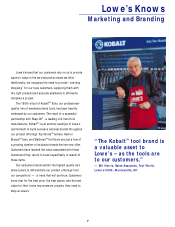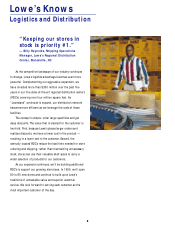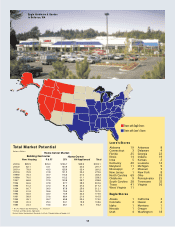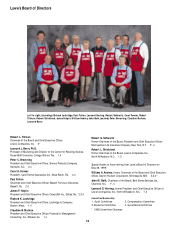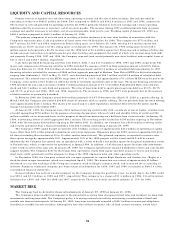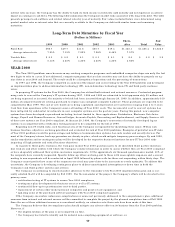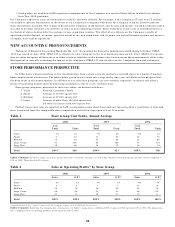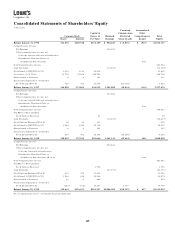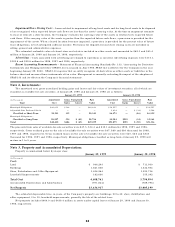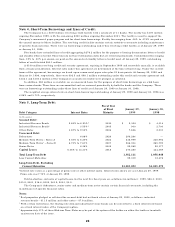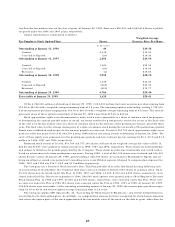Lowe's 1998 Annual Report Download - page 19
Download and view the complete annual report
Please find page 19 of the 1998 Lowe's annual report below. You can navigate through the pages in the report by either clicking on the pages listed below, or by using the keyword search tool below to find specific information within the annual report.
interest rates increase, the Company has the ability to hold its fixed income investments until maturity and not experience an adverse
impact on earnings or cash flows. The following table summarizes the Company’s market risks associated with long-term debt. The table
presents principal cash outflows and related interest rates by year of maturity. Fair values included below were determined using
quoted market rates or interest rates that are currently available to the Company on debt with similar terms and remaining
maturities.
Long-Term Debt Maturities by Fiscal Year
(Dollars in Millions) There- Fair
1999 2000 2001 2002 2003 after Total Value
Fixed Rate $98.7 $49.7 $31.8 $60.7 $19.4 $1,125.1 $1,385.4 $1,522.0
Average interest rate 7.25% 7.15% 7.99% 7.98% 8.46% 7.57%
Variable Rate $ 0.3 $ 0.2 $ 0.1 $ 0.1 $ 0.1 $ 2.3 $ 3.2 $ 3.2
Average interest rate 5.13% 4.25% 4.25% 4.25% 4.25% 3.66%
YEAR 2000
The Year 2000 problem arose because many existing computer programs and embedded computer chips use only the last
two digits to refer to a year. If not addressed, computer programs that are date sensitive may not have the ability to properly rec og-
nize dates in year 2000 and beyond. The result could be a disruption of operations and the processing of transactions.
In 1997 and 1998, the Company completed an analysis of the impact and costs relating to the Year 2000 problem and developed
an implementation plan to address information technology (IT), non-information technology (non-IT) and third party readiness
issues.
In preparing IT systems for the Year 2000, the Company has utilized both internal and external resources. Contracted program-
ming costs to convert the Company’s IT systems during 1997, 1998 and 1999 are estimated to total approximately $5 million and
are being expensed as incurred, the majority of which had been incurred through January 29, 1999. In addition, approximately $19
million of computer hardware is being purchased to replace non-compliant computer hardware. These purchases are expected to be
completed by May 1999. The cost of new hardware is being capitalized and depreciated over useful lives ranging from 3 to 5 years.
Cash flow from operations is the Company’s source of funding all Year 2000 costs. The incremental cost to convert systems has
been mitigated by substantial investments in new computer systems over the past six years. During this period, new computer
systems have been developed or purchased including, but not limited to, these applications: Distribution, Electronic Data Inter-
change, Payroll and Human Resources, General Ledger, Accounts Payable, Forecasting and Replenishment, and Supply Services. All
of these new systems are Year 2000 compliant. At January 29, 1999, the Company’s conversion of internally developed legacy
systems was completed with certification testing planned to be completed by the fall of 1999.
Regarding non-IT related risks, each functional area of the Company is responsible for identifying these issues. Within each
business function, objectives are being prioritized and evaluated for risk of Year 2000 problems. Examples of potential non-IT risks
of Year 2000 problems would be power outages and failures of communication systems, bar code readers and security devices. For
most of the Company’s stores, back-up generators are already in place, which would mitigate temporary power outages. By mid 1999,
similar remediation and/or contingency plans will be developed by the respective business functions for non-IT Year 2000 risks
impacting all high priority and critical business objectives.
In regards to third party readiness, the Company mailed Year 2000 questionnaires to all identified third parties (merchan-
dise vendors and other entities with which the Company conducts business) in order to assess whether they are Year 2000 compliant
or have adequately addressed their system conversion requirements. Of the approximate six thousand questionnaires mailed, 33% of
the recipients have currently responded. Specific follow-up letters are being sent to those with unacceptable responses and a second
mailing to non-respondents will be conducted in April 1999 followed by phone calls for those not responding within thirty days. The
Company cannot predict how many of the responses received may prove later to be inaccurate or overly optimistic. To address this
uncertainty, the Company is developing contingency plans to address unanticipated interruptions or down time in both the
Company’s and third parties’ systems and services.
The Company is continuing to closely monitor adherence to the remainder of its Year 2000 implementation plan and is cur-
rently satisfied that it will be completed by Fall 1999. For the remainder of the project, the Company’s efforts will be devoted to five
primary areas:
• certification testing of IT systems to ensure Year 2000 compliance,
• contingency plan development for business areas as well as IT systems,
• continued follow-up to questionnaires sent to third parties,
• replacement of certain older model personal computers and point-of-sale equipment, and
• updating some of the purchased software packages with Year 2000 compliant upgrades.
If the Company encounters unforeseen complications or issues not previously addressed in the comprehensive plan, additional
resources from internal and external sources will be committed to complete the project by the planned completion time of Fall 1999.
Since the use of these additional resources is considered unlikely, no estimates as to their costs have been made at this time.
The Company believes that its compliance plan should mitigate any adverse effect on its business from the Year 2000 problem.
However, if:
• the implementation of the plan is not completed on time,
• the Company has failed to identify and fix material non-complying equipment or software, or
17


